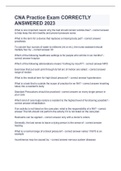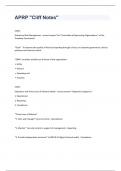𝑠=√ voor berekening s2: wortel weglaten SEM =
√𝑛
= standaardfout van het gemiddelde
𝑛−1
𝑠
CV = coefficient of variation = 𝑥 CI: 𝑥 ± (𝑍𝑐𝑟𝑖𝑡 ∗ 𝑆𝐸𝑀)𝑜𝑓 𝑥 ± (𝑇𝑐𝑟𝑖𝑡 ∗ 𝑆𝐸𝑀)
𝐴
𝐴 𝐶 𝐴∗𝐶 𝐴 𝐶 𝐴∗𝐷 𝐵∗𝐶 𝐴∗𝐷+ 𝐵∗𝐶 𝐴∗𝐶 √𝐴 𝐴
𝑥 = + = + = 𝐵
= =√ 𝐴𝑖 ∗ 𝐴 𝑗 = 𝐴𝑖+𝑗 (Ai)j = Ai * j
𝐵 𝐷 𝐵∗𝐷 𝐵 𝐷 𝐵∗𝐷 𝐵∗𝐷 𝐵∗𝐷 𝐶 𝐵 √𝐵 𝐵
𝑥− 𝑥
Z= 𝑠
= afwijking van het gemiddelde (alleen bij normaalverdeling, gebruik voor standaardisering)
(𝑥− 𝜇)2 (𝑍)2
1 − 1
pdf = 𝜎 ∗𝑒 (2𝜎)2 z- toepassen geeft: pdf = ∗ 𝑒− 2 verdeling van waarnemingen in populatie
( ) √2𝜋
√2𝜋
𝑥− 𝑥
T= als we σ niet weten (als n klein is) df = n – 1
𝑠/√𝑛
bij grote steekproeven (n > 120) nadert de verdeling van t de normaalverdeling
ES = μ2 – μ1 minimale effect waarin we nog geïnteresseerd zijn en dus willen detecteren
d = μ2-μ1/σ difference, fractie van s
Uitgaande van normaalverdeling:
𝑠2 (𝑍𝑎−𝑍𝑏)2
N= Zα: kritische z-waarde voor type-1 vergissing, Zβ voor type-2 vergissing
𝐸2
𝜎2 (𝑍𝛼−𝑍𝛽)2 𝜎(𝑍𝛼−𝑍𝛽)
A priori steekproefgrootte: 𝑛 = post hoc effectgrootte:ES =
𝐸𝑆 2 √𝑛
𝐸𝑆∗√𝑛
Power post hoc analyse: 𝑍𝛽 = 𝑍𝛼 −( 𝜎 )
𝑥−𝜇
𝑍= (rekenmachine DISTR: normalcdf upper: Z-value, P(Z>Zfound) = outcome, P = 1 – outcome)
𝑆𝐸𝑀
kritische waarde = μ0 + (Zα * SEM) Zβ = (kritische waarde – μA)/SEM
tweezijdige Zα/2 = 0.05/2 = 0.025 (gives negative and positive Zα-value) β:α = 4:1
F = VARA/VARB (grootste steekproefvariantie delen door kleinste) dfA = n – 1 dfB = n – 1
In tabel opzoeken of extreme waarde is (als extremer dan gegeven F heteroscedastisch)
ongepaarde t-toets (alleen bij gelijke varianties)
(𝑛𝑎−1)𝑆𝑎2 +(𝑛𝑏−1)𝑆𝑏2
Sp = √ gepoolde standaardafwijking als beste schatting van onbekende σ
𝑛𝑎+𝑛𝑏−2
substitutie geeft:
𝑥𝑎−𝑥𝑏 𝑥𝑎−𝑥𝑏
t= df = na + nb – 2 t=
(𝑆𝑝√
1 1
+ ) (𝑛𝑎−1)𝑆𝑎2 + (𝑛𝑏−1)𝑆𝑏2 1 1
𝑛𝑎 𝑛𝑏 √ (𝑛𝑎+𝑛𝑏)
(𝑛𝑎+𝑛𝑏−2)
gepaarde t-toets (alleen bij gelijke varianties)
Σ∆
∆= Σ∆ = optelsom van de verschillen tussen gepaarde waarnemingen
𝑛
2
Σ(Δ− Δ) 𝑆Δ 𝜇𝑎− 𝜇𝑏
S∆ = √ SEΔ = t=∆−
𝑛−1 √𝑛 𝑆𝐸∆
|𝑥− 𝑋|
outliers: Criterium van Chauvenet: Z = P(Z > Zoutcome) want minstens zo afwijkend
𝑠
outliers: Dixon’s criterium: D = |outlier – volgende waarde|, 1/3 bereik nemen (als D > 1/3 bereik geldig)
outliers: Methode van Grubb: Zsus = |Xsus - 𝑋|/s Zmax = n – 1/sqrt(n) Als Zsus > Zmax dan P < 0.05
Type-1 error rate: 1 –(1-α)C c = aantal t-tests in serie










